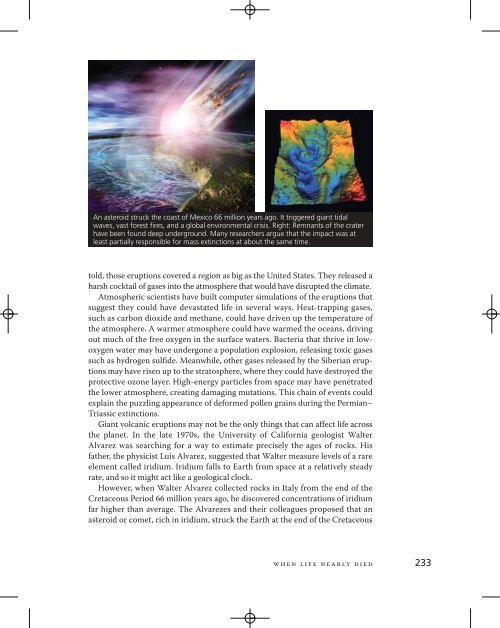Reprinted from The Tangled Bank: An Introduction to Evolution by ...
Reprinted from The Tangled Bank: An Introduction to Evolution by ...
Reprinted from The Tangled Bank: An Introduction to Evolution by ...
Create successful ePaper yourself
Turn your PDF publications into a flip-book with our unique Google optimized e-Paper software.
<strong>An</strong> asteroid struck the coast of Mexico 66 million years ago. It triggered giant tidal<br />
waves, vast forest fires, and a global environmental crisis. Right: Remnants of the crater<br />
have been found deep underground. Many researchers argue that the impact was at<br />
least partially responsible for mass extinctions at about the same time.<br />
<strong>to</strong>ld, those eruptions covered a region as big as the United States. <strong>The</strong>y released a<br />
harsh cocktail of gases in<strong>to</strong> the atmosphere that would have disrupted the climate.<br />
Atmospheric scientists have built computer simulations of the eruptions that<br />
suggest they could have devastated life in several ways. Heat-trapping gases,<br />
such as carbon dioxide and methane, could have driven up the temperature of<br />
the atmosphere. A warmer atmosphere could have warmed the oceans, driving<br />
out much of the free oxygen in the surface waters. Bacteria that thrive in lowoxygen<br />
water may have undergone a population explosion, releasing <strong>to</strong>xic gases<br />
such as hydrogen sulfide. Meanwhile, other gases released <strong>by</strong> the Siberian eruptions<br />
may have risen up <strong>to</strong> the stra<strong>to</strong>sphere, where they could have destroyed the<br />
protective ozone layer. High-energy particles <strong>from</strong> space may have penetrated<br />
the lower atmosphere, creating damaging mutations. This chain of events could<br />
explain the puzzling appearance of deformed pollen grains during the Permian–<br />
Triassic extinctions.<br />
Giant volcanic eruptions may not be the only things that can affect life across<br />
the planet. In the late 1970s, the University of California geologist Walter<br />
Alvarez was searching for a way <strong>to</strong> estimate precisely the ages of rocks. His<br />
father, the physicist Luis Alvarez, suggested that Walter measure levels of a rare<br />
element called iridium. Iridium falls <strong>to</strong> Earth <strong>from</strong> space at a relatively steady<br />
rate, and so it might act like a geological clock.<br />
However, when Walter Alvarez collected rocks in Italy <strong>from</strong> the end of the<br />
Cretaceous Period 66 million years ago, he discovered concentrations of iridium<br />
far higher than average. <strong>The</strong> Alvarezes and their colleagues proposed that an<br />
asteroid or comet, rich in iridium, struck the Earth at the end of the Cretaceous<br />
when life nearly died 233

















